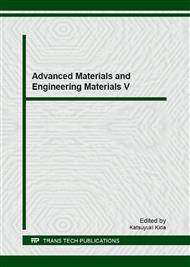[1]
C. L. Bryant, in: C. M. Blow, and C. Hepburn (Eds. ), Rubber Technology and Manufacture 2nd, Butterworths, London, 1982, Chapter 4.
Google Scholar
[2]
J. A. Brydson, Rubbery Materials and Their Compounds, Elsevier Applied Science, Amsterdam, 1988, 187-205.
Google Scholar
[3]
D. C. Blackley, Synthetic Rubber : Their Chemistry and Technology, Applied Science Publishers, Iblrking, 1983, 126-141.
Google Scholar
[4]
L. Evans, and E. G. partridge, Rubber Age. 94 (1963) 272.
Google Scholar
[5]
Donald A. Seil, and Fred R. Wolf, Nitrile and Polyacylic Rubbers, in: Morton, Maurice (Eds. ), Rubber Technology 3nd, Van Nostrand Reinhold Company Inc., New York, 1987, Chapter 11.
Google Scholar
[6]
A. F. Blamchard, in: W. J. S. Naunton (Ed. ), The Applied Science of Rubber, Edward Arnold Ltd., London, 1961, 414-474.
Google Scholar
[7]
H. Alter, J. Appl. Polym. Sci., 9 (1965) 234-240.
Google Scholar
[8]
G. Guth, J. Appl. Phys., 16 (1945) 20.
Google Scholar
[9]
Y. Santo, and J. Farukawa, Rub. Chem. Technol., 35 (1962) 857.
Google Scholar
[10]
G. Kraus, in: F. R. Eirch (Ed. ), Science and Technology of Rubber, Academic Press., New York, 1978, 339.
Google Scholar
[11]
A. Voet, J. Polym. Sci., 15 (1980) 327.
Google Scholar
[12]
F. Bueche, in: G. Krasus, (Ed. ), Reinforcement of Elastomers, Interscience Publishers, John Wiley and Sons., New York.
Google Scholar
[13]
A. E. Oberth, Rub. Chem. Technol., 40 (1967) 1337-1363.
Google Scholar
[14]
S-H. Zhu, and C-M. Chan, Polym. Eng. Sci., 39 (1990) (1998).
Google Scholar
[15]
C. Sirisinha, S. Limcharoen, and J. Thunyarittikorn, J. Appl. Polym. Sci., 85 (2001) 1232.
Google Scholar
[16]
S. Saha, Eur. Polym. J., 37 (2001) 399.
Google Scholar
[17]
J. Clake, B. Clarke, and P. K. Freakley, Rubber Chem Technol., 74 (2000) 1.
Google Scholar
[18]
S. J. Ahn, K. H. Lee, B. K. Kim, and H. M. jeong, Appl. Poly. Sci., 78 (2000) 1861.
Google Scholar
[19]
E. H. Tan, S. Wolff, M. Haddeman, H. P. Grewatta, M. J. Wang, Filler-elastomer interactions. Part IX. Perfomance of silicas in polar elastomers, Rubber Chem. Technol., 37 (1992) 594.
DOI: 10.5254/1.3538332
Google Scholar
[20]
B. karaagac, M. Inal V. Deniz, Mater. Des., 30 (2009) 1685.
Google Scholar
[21]
J. S. Dick, Rubber technology: compounding and testing for performance, Munich: Hanser publisher, (2001).
Google Scholar
[22]
M. Maurice, Rubber technology third edition. Netherland: Kluwer Academic Publishers, (1999).
Google Scholar
[23]
S. S. Choi, and J. C. Kim, Lifetime prediction and thermal aging behaviors of SBR and NBR composites using crosslink density changes, J Ind Eng Chem., 18 (2012) 1166-1170.
DOI: 10.1016/j.jiec.2012.01.011
Google Scholar
[24]
Nicholas P. Cheremisinoff, in: Susmita Bhattacharjee, Anil K. Bhowmick, and Bhola Nath Avasthi, Elastomer Technology Handbook, Morhanville, New Jersey, 1993, 520-524.
Google Scholar
[25]
J. Hanley, N. Murphy, H. Ali, and S. Jerrams, The Effect of Oil Swelling on the Fatigue Life of Elastomers subjected to Cyclic Bubble Inflation, 11th International Seminars on Elastomers, Sept, Freiburg, Germany, 2007, 23-27.
DOI: 10.5254/1.3548224
Google Scholar
[26]
R. Guo, A. G. Talma, R. N. Datta, W.K. Dierkes, J.W.M. Noordermeer, Solubility study of curatives in various rubbers, Eur. Polym. J., 44 (2008) 3890-3893.
DOI: 10.1016/j.eurpolymj.2008.07.054
Google Scholar
[27]
G. Liu, M. Hoch, S. Liu, K. Kulbaba, and G. Qiu, Quantitative exploration of the swelling response for carbon black filled hydrogenated nitrile rubber with three-dimensional solubility parameters, polym. Bull., 72 (2015) 1961-(1974).
DOI: 10.1007/s00289-015-1383-7
Google Scholar
[28]
A. F. M. Barton, Handbook of solubility parameters and other cohesion parameters 2nd, CRC Press, Boca Raton, 1991, chapter 5.
Google Scholar
[29]
S. Hayashi, H. Sakakida, M. Oyama, and T. Nakagawa, Low-temperature properties of hydrogenated nitrile rubber (HNBR), Rub. Chem. Technol., 64 (1991) 534-544.
DOI: 10.5254/1.3538571
Google Scholar
[30]
N. Rattanasom, and S. Prasertsri, Relationship among mechanical properties, heat aging resistance, cut growth behaviour and morphology in natural rubber: partial replacement of clay with various types of carbon black at similar hardness level. Poly Test., 28 (2009).
DOI: 10.1016/j.polymertesting.2008.12.010
Google Scholar


